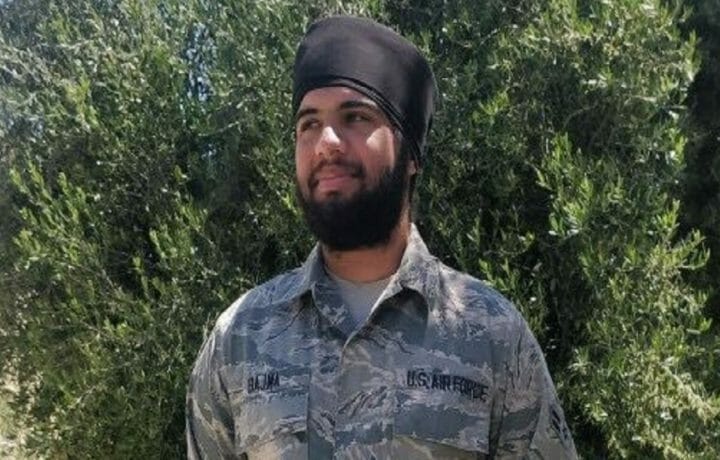Last week the U.S. Air Force announced that it had updated its regulations, and will allow airmen to seek a waiver to wear turbans, hijabs or beards for religious reasons. This is an update to AFI 36-2903, “Dress and personal appearance of Air Force Personnel,” and will allow the headdress to be worn provided it is “neat and conservative” and that the airmen present a professional and well-groomed appearance.
This includes under-turbans or patkas, and other indoor or outdoor head coverings that are worn for religious reasons. In addition to the headwear, the rules address unshorn beards and unshorn hair – which is typically worn by those of the Sikh faith. Airmen must still have a religious or medical exemption to grow beards, and the guidelines for such remain unchanged. Whiskers cannot be trimmed to give a sculpted appearance nor can the whiskers exceed a quarter-inch in length.
Requests for such an exemption to U.S. Air Force policy will only be denied if the policy “furthers a compelling government interest,” and moreover, if it is the least restrictive way of furthering that interest, the Air Force Times reported.
Already, the Air Force has granted airmen permission to wear beards, turbans and hijab for religious reasons, with Staff Sgt. Abdul Rahman Gaitan being the first Muslim to receive a beard waiver in 2018. In June of last year Airman 1st Class Harpreetinder Singh Bajwa became the first active-duty Sikh airman allowed to wear a turban, beard and long hair – the latter tied in a bun and then covered by the turban.
Singh, a crew chief at the McChord Air Force Base near Lakewood, WA, was granted the accommodation after he made a request for it in coordination with the American Civil Liberties Union and the Sikh American Veterans Alliance.
“I am grateful to hear of this policy change, because it codifies in writing what I already know: The U.S. Air Force values the service and contribution of religious minorities like me,” Singh said in a statement provided by the Sikh Coalition to the Air Force Times. “Accommodations, after all, aren’t about special treatment — they are about ensuring that religiously observant Sikhs and others don’t have to choose between staying true to our faith and serving our country.”
The Sikh Coalition, which is the largest Sikh civil rights organization in the United States, has worked with more than 20 Sikh Americans serving in the military and applauded this decision by the Air Force.
This comes more than 100 years after Bhagat Singh Thind – a Sikh Indian immigrant – who served in the U.S. Army during the First World War and was first member of the U.S. military to be allowed to wear a turban as part of his uniform for religious reasons.
Last year Captain Maysaa Ouza became the first Air Force Judge Advocate General Corps officer to wear a hijab, the head covering worn in public by some Muslim women. Ouza, the daughter of Lebanese immigrants, was featured in an NBC documentary, and in it she described her efforts to seek a religious accommodation to wear the hijab when she entered the competitive process to become a JAG officer.
“We support these new guidelines as a step toward religious accommodation and inclusion for military personnel of all faiths,” said Council on American-Islamic Relations (CAIR) National Communications Director Ibrahim Hooper via a statement. “Thousands of American Muslims and members of other minority faiths serve in our nation’s military and should be able to practice their faith while serving.”
It isn’t just those of Sikh or Muslim faith that have applied for the religious exemptions. There have been at least two airmen who reportedly follow the Norse Heathen, or pagan faiths, and were granted permission to wear a beard.
Uniformity In Head Covering
According to the new regulations, the hijab, as well as turbans and under-turbans, should be made of subdued material in a color that resembles or is otherwise close to the airman’s assigned uniform – this could be black, brown, green, tan or navy blue. If the airman is assigned to a unit that wears a beret, the unit commander can order the airman to wear a turban of the same color.
In addition, the hijab and turban must be free of designs and any markings; however the turban could match the Airman Battle Uniform or Operational Camouflage Pattern (OCP) uniform.
In the case of turbans an airman’s rank will be displayed when the headdress is worn in circumstances where military headgear is customarily worn, and the rank insignia is to be removed when military headgear is not typically worn – notably when the wearer is indoors or other no-hat/no-salute area.
Moreover, accommodations to wear the hijab or turban may be suspended or even withdrawn if an airman is assigned to a hazardous duty or environment. This could include the treatment of chemical or biological weapons; and commands may also demand that an airman must share and/or remove headgear to ensure that a gas mask fits properly in the event of an attack.
Finally, an airman could be ordered to remove a turban if he goes within 25 feet of an operating aircraft.




